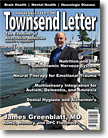|
In the 2016 Lyme edition of the Townsend Letter, we introduced the Provoked Lyme Urine PCR test. The goal of this article is to share current practices and new findings using the Provoked Lyme Urine PCR test.
As clinicians, we realize the limitations of laboratory testing for Lyme disease and often rely on clinical history and physical exam to make a diagnosis. The limitations of current laboratory methods for Lyme are multifactorial. One potential constraint is that we attempt to diagnose Lyme by identifying antibodies (ELISA, Western blot, and LTT) in patients who have weakened and compromised immune systems. A white blood cell cannot produce antibodies if it is invaded by spirochetes or Bartonella-like organisms and struggles for its own survival. In the past, in clinical practice, many patients improve with antimicrobial Lyme-directed treatment – in spite of a negative Western blot, ELISA, or lymphocyte transformation test (LTT-ELISPOT).
Another limitation of lab testing is that we look for evidence of Lyme in body fluids or tissues where spirochetes do not reside. For example, dark-field microscopy, conventional PCR tests, or the new "Borrelia culture" look for microbes or their DNA in the blood. Once infected with Lyme, Lyme has a brief blood-borne phase and concentrates in the connective tissue, inside neurons or ganglia, inside lymph nodes, in the fascia, and in other tissues or organs. Even more questionable is the attempt to search for Lyme spirochetes in the cerebrospinal fluid after doing a spinal tap.
 Townsend Letter provides a platform for those examining and reporting on functional and integrative medicine. Please support these independent voices. Townsend Letter provides a platform for those examining and reporting on functional and integrative medicine. Please support these independent voices. |
As far back as 1998, a study already showed that spirochetes immediately give up their spirochete-form and shift into the "round body" shape when they get in contact with spinal fluid (Brorson, & Brorson, 1998). The round body is not detectable with the typical tests the lab applies when searching for living spirochetes.
The provoked urine PCR test was conceived and innovated by us out of the necessity to give patients more objective information to understand why they are sick – and to help them find appropriate treatment. With an objective DNA-based test, we have attempted to support our current clinical knowledge and answer the big questions: Is this patient infected with Lyme or one of the co-infections? If so, where in the body is the infection? Has the treatment worked; are the remaining symptoms a mysterious post-Lyme illness, or is the infection still active?
 Currently we use the PCR test performed by DNA Connexions, Colorado Springs, Colorado. The Lyme panel tests for four different genes of Borrelia burgdorferi and several common Lyme disease co-infections: Babesia microti, Babesia divergens, Babesia duncani, Bartonella bacilliformis, Bartonella henselae, Bartonella quintanta, Borrelia miyamotoi, Borrelia recurrentis, Ehrlichia chaffensis and Anaplasma phagocytophilum. According to the company and consistent with common knowledge, a positive PCR-based Lyme test indicates the presence of DNA from Borrelia burgdorferi and/or other co-infections. The PCR test has high specificity (this means, if the test says, "you have Babesia microti," you have Babesia microti), but is falsely known to have low sensitivity: if you look in the blood for a microbe that doesn't live there anymore, you won't find it there with this test. You have to actually look for the microbes where they currently live! Currently we use the PCR test performed by DNA Connexions, Colorado Springs, Colorado. The Lyme panel tests for four different genes of Borrelia burgdorferi and several common Lyme disease co-infections: Babesia microti, Babesia divergens, Babesia duncani, Bartonella bacilliformis, Bartonella henselae, Bartonella quintanta, Borrelia miyamotoi, Borrelia recurrentis, Ehrlichia chaffensis and Anaplasma phagocytophilum. According to the company and consistent with common knowledge, a positive PCR-based Lyme test indicates the presence of DNA from Borrelia burgdorferi and/or other co-infections. The PCR test has high specificity (this means, if the test says, "you have Babesia microti," you have Babesia microti), but is falsely known to have low sensitivity: if you look in the blood for a microbe that doesn't live there anymore, you won't find it there with this test. You have to actually look for the microbes where they currently live!
Antibody tests (Western blot, IgG, IgM, LTT) are far less specific but more forgiving. If the cells of the immune system migrate through the tissues where the microbes hide and get in contact with them without being hurt, and then get back into the blood, you may find evidence of the contact with the pathogen in the blood – if the white cell is alive and still healthy enough to create and secrete related antibodies into the blood, where they are then looked for.
At our Sophia Health Institute, we use and further developed ART (autonomic response testing), an extension of the standard physical exam and a non-invasive technique that uses muscle-biofeedback. This allows us to use cultures of Lyme, Babesia, EBV, etc. and the "Resonance Phenomenon between Identical Substances" (first described and published by Y.Omura MD in 1986 in the International Journal of Acupuncture and Electro-Therapeutics Research) to find the body tissues and compartments that have become the sanctuary cities of the pathogens.
Our results have shown that ART in the hands of an experienced practitioner has 94% sensitivity. This means, in 94% of patients where we, for example, find Bartonella henselae, the PCR test – if it is applied as discussed below – will also show the presence of the identical microbial species. ART has a specificity of 88%. That means if we find, with non-invasive ART, the pathogen Babesia microti, there is an 88% chance it really is exactly that, but a 12% chance it might be Babesia duncani or Babesia divergens – a difference that might clinically be irrelevant.
To perfect the existing provoked PCR testing procedure, we first evaluated patients with chronic myofascial pain who tested negative or "indeterminate" with the Western blot test. We used manual ART testing with diluted microbial cultures to detect if (and where) in the body we can find resonance or evidence of the presence of specific pathogens. We then applied deep tissue bodywork to these areas, collected the urine afterwards for six hours, and sent the urine for PCR testing. Out of the first 150 samples, only two were negative. Most showed the presence of several species of Lyme and co-infections, proving three points:
1. To detect and diagnose pathogens in the blood or urine, they have to be displaced from their sanctuary into the blood first, using an appropriate technique.
2. Tissues that are injured or chronically strained become the preferred sanctuaries for pathogens, perpetuating the original pain or symptom.
3. Most pathogens are tissue specific; they do not live randomly dispersed in the body and body fluids. They have firmly established domiciles, which determine the patient's symptoms. If Babesia protozoae live in the amygdala, the patient might be depressed. If they live in the endothelium of the brain's vascular system, the client may have chronic migraines. If they live in the vagus nerve, the patient may have all the symptoms of a leaky gut or SIBO. If they live in the myelin of the brain or spinal cord, the patient may have all the symptoms of MS.
However well we succeeded in tracking the true causes of myofascial pain, we struggled to find appropriate methods to tease pathogens out of the brain and spinal cord. Deep tissue massage is obviously not possible when the tissues are protected by the skull or spinal vertebrae.
Through our personal friendship with the radiologist and world-renowned ultrasound expert Prof. Dr. Marco Ruggiero (who has over 200 peer-reviewed publications), we found that ultrasound was the perfect tool to reach inside the brain and spinal cord to displace significant numbers of pathogens from their sanctuaries, so we could detect them in the blood, or later in the urine. Since the kidneys do the work for us to concentrate unwanted microbial, toxic, or allergenic elements in the urine, the urine is the ideal body fluid for our work. Doing the PCR test on a six-hour urine collection remains our principal tool to evaluate patients with chronic illness.
In the March 2017 issue of the Journal of Immunology, Dietrich Klinghardt MD, PhD, and Prof. Marco Ruggiero published the landmark article "The Ruggiero Klinghardt (RK) Protocol for the Diagnosis and Treatment of Chronic Conditions with Particular Focus on Lyme Disease." It discusses the need to make pathogens "visible" to the immune system and detectable in laboratory testing, using provocation techniques such as ultrasound. The article also shows the importance of including manual ART testing in the physical exam of any patient with chronic illness, since it can predict where the pathogen's sanctuaries are and where the ultrasound – or bodywork – should be applied. It shows ultrasonography pictures that consistently reveal and confirm the specific pathology in the tissues that were first determined only with ART.
At Sophia Health Institute, we use the following RK/ultrasound protocol for provocation. The instrument used is a standard therapeutic ultrasound device (cost: less than 900 USD). The patient is treated in a supine position. If needed for diagnostic precision, a six-hour urine collection is done before the ultrasound treatment. The following settings, treatment, locations, and times are used:
- Bladder – 50% pulsed 1Mhz 0.5W/cm² for 2 minutes
- Spleen – 50% pulsed 1Mhz 0.5W/cm² for 2 minutes
- Vagus – 20% pulsed 3.3Mhz 0.5W/cm² for 1 minute each side with a mild neck extension
- Temple – 10% pulsed 3.3Mhz 0.5W/cm² for 1 minute each side
- Submandibular/Salivary glands – 20% pulsed 3.3Mhz 0.5W/cm² for 1 minute each side.
After the procedure, the urine is collected for six hours and an aliquot sent in for PCR testing (ideally along with the pre-provocation urine test).
In addition, we like to include all areas that tested with ART for the presence of Lyme-related pathogens, using the same parameters as above. We may include the symptomatic knee joint, the ailing heart, or the area where the client has fascial pain. If pain or symptoms are in organs or tissues that can be manually compressed (intestines, liver, muscles, fascia, peripheral nerves), we also include simple repeated manual compressions of those body areas or compartments or Yoga-type stretches of the area. Examples of the manual techniques – liver compression, cranial compression, self-lymphatic message, etc. – are demonstrated on our website. They can be viewed at www.sophiahi.com/videos. We also offer an evening introduction of the RK protocol in order to teach it to NDs, DOs, MDs, etc.
The provoked PCR test can also be used for very specific issues. If a client has localized symptoms (prostate cancer, discogenic low back pain, Achilles tendon rupture, and so on), ultrasound or body work can be applied just to that area with a pre- and post-urine collection. Whatever shows up in the post-provocation test that did not show up in the pre-test has to be from the area that was provoked! Beyond the RK protocol, we also use testing for heavy metals (aluminum, mercury, etc.), cancer cells, and other issues in the same manner. The results are revolutionary and go beyond what we can discuss here.
The choice of organs and regions of the body in the standardized RK protocol are not only based on our experience with ART but also on our current knowledge of Lyme. Lyme spirochetes are found in the lining of the bladder wall. Patients with Lyme often have bladder symptoms ranging from interstitial cystitis to chronic urinary tract infections to neurogenic bladder and so on. In a mouse study, spirochetes were most commonly found in the bladder wall (Schwan, Burgdorfer, Schrumpf, & Karstens, 1988). This same article demonstrated spirochetes in the spleen. Lyme patients often have autonomic dysfunction with the vagus nerve most commonly being affected. The vagus nerve innervates the lungs, thymus, heart, liver, kidneys, and intestines.
 Dr. Ruggiero and Dr. Bradstreet (2014) utilized transcranial ultrasonography to view cortical abnormalities and increased extra-axial fluid in patients with autism. By placing ultrasound on the thin bone of the temples, we can activate the brain's lymphatic system to drain its gluey contents downstream. Ultrasound not only offers diagnostic efficacy but also therapeutic effects. Dr. Ruggeiro and Dr. Bradstreet's article describes the therapeutic effect of ultrasound on the glymphatic system (glia-dependent lymphatic system of the brain). Dr. Ruggiero and Dr. Bradstreet (2014) utilized transcranial ultrasonography to view cortical abnormalities and increased extra-axial fluid in patients with autism. By placing ultrasound on the thin bone of the temples, we can activate the brain's lymphatic system to drain its gluey contents downstream. Ultrasound not only offers diagnostic efficacy but also therapeutic effects. Dr. Ruggeiro and Dr. Bradstreet's article describes the therapeutic effect of ultrasound on the glymphatic system (glia-dependent lymphatic system of the brain).
We also included the submandibular lymph glands, in order to provoke the lymphatic fluid to drain its viscous content into the venous system of the neck. Co-infections such as Bartonella often cause cervical lymphadenopathy and become diagnosable and visible in the following urine collection. For example, we performed the RK protocol on this chronically ill patient and did pre- and post-provocation urine PCR tests (only with ultrasound). The pre-urine test was negative, while the post-provocation demonstrated Borrelia and Bartonella.
In conclusion, the provoked Lyme urine PCR test used with the RK protocol is currently by far the most sensitive and – when applied properly – also the most tissue-specific test for Borrelia burgdorferi and the multitude of relevant co-infections and opportunistic infections. It's also easy to learn, uses only FDA-approved, affordable equipment, and is more cost-effective than other current test methods. The provoked PCR test and the RK protocol have proven what our Lyme-literate mentors and the ILADS organization have predicted 30 years ago: Lyme is truly the plague of the 21st century, and patients should no longer be denied a proper work-up, diagnosis, and treatment.
The provocation technique can not only be applied for Lyme and co-infections, but also should be considered for other pathogens and toxins such as heavy metals and glyphosate, for certain brain peptides, and for cancer markers and cells. Every medical condition, every symptom we know should be given another look. Is the lymphoma or osteoporosis really, deep down, caused by Bartonella? Is the discogenic low back pain an outcome of Lyme spirochetes having slowly eaten away at the disc? Is your child's autism not improving with the biomedical approach because the spirochete or Babesia infection in the brain has been missed? Is your mental decline caused by attacks of the immune system directed at the aluminum deposits in your endothelial lining of the brains vasculature? Can we diagnose breast or prostate cancer without needle biopsy, simply by applying ultrasound and looking for cancer cells, glyphosate, or aluminum in the blood afterwards?
A thousand questions will rise to the surface soon, but this time with logical, affordable, and beautifully simple treatment solutions. The RK protocol allows us to diagnose the causes of illness pre-mortem, not post-mortem, and offers a new avenue to early diagnosis and monitoring of treatment efficacy and outcome. The diagnostic procedure rarely takes more than 15 minutes and can be done in the office of any ND, DO, or MD. The ART-part of the procedure deepens the diagnostic capability and effectiveness of the method and also allows us to find the most effective and best tolerated treatment modality, though it takes a bit longer to learn. We invite you to learn from us, communicate with us, criticize us – or join us on this exciting journey.
References
Bradstreet J, et al. A New Methodology of Viewing Extra-Axial Fluid and Cortical Abnormalities in Children with Autism via Transcranial Ultrasonography. Front Hum Neurosci. 2013; 7: 934.
Brorson O, Brorson, S. (1998). In vitro conversion of Borrelia Burgdorferi to cystic forms in spinal fluid, and transformation to mobile spirochetes by incubation in BSK-H medium. Infection. 1998; 26(3), 144-150.
Klinghardt, D, Ruggiero M. (2017). The Ruggiero-Klinghardt (RK) Protocol for the Diagnosis and Treatment of Chronic Conditions with Particular Focus on Lyme Disease. American Journal of Immunology. 2017; 13(2): 114-126.
Omura Y. Electro-Magnetic Resonance Phenomenon as a possible mechanism related to Bi-Digital O-Ring Test Molecular Identification and Localization Method. Acupuncture & Electro-Therapeutics Research. 1986; 11(2), 127-145.
 Dietrich Klinghardt, MD, PhD, was born, raised and educated in West Germany, where he graduated from Freiburg Medical School/Albert Ludwigs University in 1975. He also studied psychology and completed a 3-year research project/PhD in angiology. He is internationally known for his successful treatment of chronic pain and illness. Dr. Klinghardt combines nonsurgical orthopedic medicine with immunology, endocrinology, toxicology, neural therapy, hypnotherapy, and energy psychology. He has been in practice for over 40 years and has been a pioneer in the diagnosis and treatment of Lyme disease, applying his 5 Levels of Healing model. Dr. Klinghardt founded Sophia Health Institute in Woodinville, Washington, where he sees patients. Dietrich Klinghardt, MD, PhD, was born, raised and educated in West Germany, where he graduated from Freiburg Medical School/Albert Ludwigs University in 1975. He also studied psychology and completed a 3-year research project/PhD in angiology. He is internationally known for his successful treatment of chronic pain and illness. Dr. Klinghardt combines nonsurgical orthopedic medicine with immunology, endocrinology, toxicology, neural therapy, hypnotherapy, and energy psychology. He has been in practice for over 40 years and has been a pioneer in the diagnosis and treatment of Lyme disease, applying his 5 Levels of Healing model. Dr. Klinghardt founded Sophia Health Institute in Woodinville, Washington, where he sees patients.

Dr. Christine Schaffner is a board-certified naturopathic physician who graduated from Bastyr University. She completed her undergraduate studies in pre-medicine and psychology at the University of Virginia in Charlottesville, Virginia. Dr. Schaffner specializes in the treatment of chronic illness and is the clinic director of Sophia Health Institute in Woodinville, Washington.
Consult your doctor before using any of the
treatments found within this site.

Subscriptions
are available for
Townsend Letter, the Examiner of Alternative Medicine
magazine, which is
published 10 times each year. Search our pre-2001
archives for further information. Older issues of the printed magazine
are also indexed for your convenience.
1983-2001
indices ; recent indices. Once you find the magazines you'd like to order, please
use our
convenient form, e-mail subscriptions@townsendletter.com,
or call 360.385.6021. |
![]()
![]()









 Dietrich Klinghardt, MD, PhD, was born, raised and educated in West Germany, where he graduated from Freiburg Medical School/Albert Ludwigs University in 1975. He also studied psychology and completed a 3-year research project/PhD in angiology. He is internationally known for his successful treatment of chronic pain and illness. Dr. Klinghardt combines nonsurgical orthopedic medicine with immunology, endocrinology, toxicology, neural therapy, hypnotherapy, and energy psychology. He has been in practice for over 40 years and has been a pioneer in the diagnosis and treatment of Lyme disease, applying his 5 Levels of Healing model. Dr. Klinghardt founded Sophia Health Institute in Woodinville, Washington, where he sees patients.
Dietrich Klinghardt, MD, PhD, was born, raised and educated in West Germany, where he graduated from Freiburg Medical School/Albert Ludwigs University in 1975. He also studied psychology and completed a 3-year research project/PhD in angiology. He is internationally known for his successful treatment of chronic pain and illness. Dr. Klinghardt combines nonsurgical orthopedic medicine with immunology, endocrinology, toxicology, neural therapy, hypnotherapy, and energy psychology. He has been in practice for over 40 years and has been a pioneer in the diagnosis and treatment of Lyme disease, applying his 5 Levels of Healing model. Dr. Klinghardt founded Sophia Health Institute in Woodinville, Washington, where he sees patients. 